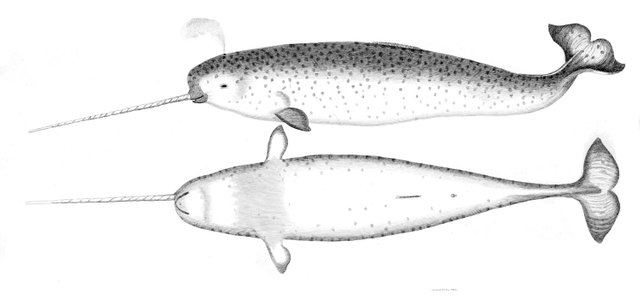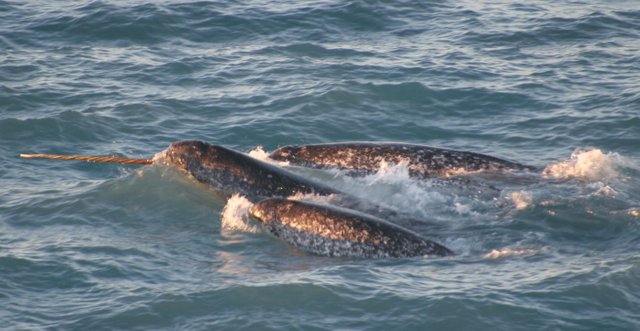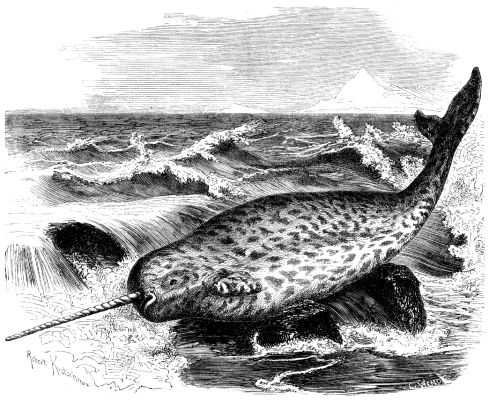When narwhals (Monodon monoceros) rub their tusks together, it is believed to be to share information about the water, not as a sign of aggressive rivalry
Narwhals (Monodon monoceros) are really cool animals. This unicorn of the sea is found in the Arctic waters around Greenland, Russia and Canada, and is best known for its helical tusk that can be as long as 3 meters. All males have them, and some females also grow a horn, but research suggest that only about 15 % of the females get a horn.

A sketch of a narwhal. Image is Public Domain.
The tusk of the narwhal is not really a tusk or horn per se; it is in reality an elongated upper left canine tooth, the equivalent of the teeth you probably use when you want to break of parts of meat to eat (it's the one next to your four upper front teeth).
The narwhal is one of only two living members of the family Monodontidae (the other being the beluga whale). It can grow to be a little over 5 meters long, and weight over 1,500 kilograms.
It feeds mostly on benthic fish such as flatfish, but can also grab cob and halibut during the summer. To reach the sea floor they have been recorded of diving as far as 1,500 meters down in the sea, with dives that can last up to 25 minutes.

A group of narwhals. Image is Public Domain.
That was a very quick into to an incredible animal, and for the rest of the post we will take a closer look at the use of its “unicorn horn”, and how we have changed our theory about how and why it is used.
Why they have their characteristic horn
Charles Darwin apparently believed that the horn of the narwhal was a secondary sexual structure, much like the big feathers of the peacock. This means that the horns would be used to both attract females, as well as the likely aggressive combat between males.
Some biologists also went one step further with the combat theory, and suggested that the horns might be weapons that the males used as a spar to impale other narwhals during combat for females.
These theories sound very logical, and we see both these features in several other animals both on land and at sea.

Image is Public Domain.
Martin Nweeia from Harvard University recently published a vastly different hypothesis based from studying the anatomy of the tusk/horn. He and his research team believe that the tusk acts as a sensory organ that is mainly used for communication, and has nothing to do with combat at all.
First they figured out that the composition of the tusk is made of distinct layers, including a permeable outer layer that is used to channel seawater to the inner layer, and further to the central core that is full of nerve endings and blood vessels.
Knowing this the team took the research one step further and applied different types of water to the horn, and saw that the heart rate changed based on whether it was saline water or freshwater that was added. A higher salt concentration led to a higher heart rate, and essentially suggested that they are able "feel" the concentration of salt in the water.

Image is Public Domain.
While this information might not sound useful to us humans, it is very nice for narwhals and other animals who live in areas where there is a lot of change in the salinity of the water. A low salt concentration can tell the narwhal that the ice is melting in the area where the water is coming from, or a high salt concentration can tell it that there is no melting in progress.
The scientists goes as far as believing that this information can be shared among the males by touching the horns against each other, and thus telling the other whales where there is ice, and where the ice has already melted.
Not everyone accepts this theory
It is worth to keep in mind that this theory is not really commonly accepted, and many biologists believe it to be wrong, or at least incomplete. I guess you have to decide for yourself, but hopefully more research in the future will shed light on this debate.
The reason why a lot of people are skeptical is because of the study design of the research, where the heart rate was measured after the whale being caught by the research team. Some argue that this is what lead to the different heart rate when it was exposed to different concentrations of saline water. Other believe that while this might affect the heart rate to a certain effect, the evidence is still strong enough to be believable.
Another point that makes this theory a bit strange is that since only 15 % of the females grow a horn, these would have a clear advantage over the other females, which over time would lead to more females having them (due to natural selection favoring the horned females). And I agree that it does sound kind of strange that 85 % of the females are missing out on a very useful sensory organ.
There are probably many more narwhal secrets
The narwhals are really cool animals, but they spend most of their time hidden away under the ice that covers a lot of the Arctic sea. No one really knows a lot about the narwhals despite them being of ecological importance in the area, so I am sure we will see many interesting discoveries from this species as our technology allows us to study them even in the winter.
Thanks for reading
If you want to learn more about narwhals, then I suggest checking out narwhal.org. This website is ran by Dr. Martin T. Nweeia, the same person who lead the study that hypothesizes that the horn is in fact a sensory organ. This post at Harvard’s website is also worth checking out. Thanks for reading!
About @valth
Hey, I'm @valth - the author of this post. I love to write about nature, biology, animals, nature conservation, ecology and other related branches of science, and I occasionally write about my life, about Steem or about random stuff as well. I'm trying my best to write at least one post every day, so make sure to give me a follow if you enjoy my content and want to see more of it.
Join the @valth community!
I love nothing more than to engage with my readers, so please join the @valth community in the comment section. You will definitely find more information about the topic, personal experiences, questions, and even opposing views down there, so don't miss out on learning more.
I always reward users who post good comments, so please take the opportunity to share your views and get a small upvote in exchange for it.
This is a test comment, notify @kryzsec on discord if there are any errors please.
Being A SteemStem Member
Thanks for the upvote!
I wonder why the "probe" would need to be external. It seems like a large probe that seems to offer little benefit over some internal or skin sensor. Maybe it's multifunctional defence plus probing.
That's a good question. While you might be right about the multifunction of the horn, here's what I believe is the reason why this sensory organ is in the shape of a horn, and not in the skin itself.
As you can read in the research paper I linked to, the horn is extremely sensitive, which is probably necessary for picking up the salt concentration change. Since the narwhal lives in very cold water, they need lots of fat between the skin and the organs to stay warm, so it would most likely be very difficult to have such sensitive sensors there. A horn gives them a huge surface area to pick up on the salt concentration, while having a very small contact point between the body and the horn, minimizing the amount of heat that gets lost due to this organ.
The most of this is my own hypothesis, so it might of course be wrong, and there could be an entire different reason ;)
I tend to agree with your hypothesis. As a defensive weapon, a horn that long seems unwieldy, when compared to the much more versatile claws and teeth other animals have at their disposal.
Yep, that's a good point. It would probably be very inefficient for hunting and dueling with.
I never thought of that. I wonder if there is a correlation between animals with lots of fat/blubber and having less sensitive skin? It does seem efficiecient to have a large surface area with little contact to the body for heat preservation.
Good question! I would assume so. While our own nerves are in the top layer of our skin, I don't see why this would make any sense for animals that often get exposed to uncomfortable situations (such as whales who swim in almost freezing water). Sadly I'm not very knowledgeable about animal physiology / anatomy, so I can't really answer you. Sorry!
@valth your sensor hypothesis seems logical and I convincing...
Great post! Honestly, I hate to say it, but until you wrote this, I never knew that a narwhal was a real animal. I've seen references before and a silly video on Youtube, but I always figured they were like a unicorn, as in, a mythical creature or something.
As for the whole horn theory, however, I think I might have an idea that makes sense. Thinking back on my research about epi-genetics, I recall one video in particular that talked about homosexuality in various species. The premise was that homosexuality was less about sex, and more about survival. If all males were homosexual, it would be problematic, but if all males were straight, it would be equally problematic since they would all be competing for a limited amount of sexual partners. With that said, epi-genetics kicks in depending on the family dynamic to adjust for the occasion to balance out the skill sets among the members in the group. Not all males should be warriors and not all females should be geared towards gathering and bearing children.
Getting back to the topic of narwhals, I believe that the small percentage of females that have a present horn is directly related to their group dynamic. If there is less males than a normal group would have, (whatever that would be...,) then the likelihood of the females born into that family with a horn increases.
Obviously, if science doesn't know the answer, I couldn't possibly know (after all, I just found out they exist...) Considering, however, what I have read about epi-genetics and hierarchy within animal groups, I don't believe that it it too far-fetched. To me, it makes sense that all of the males would have it if they act as the scouts for the group since it would be essential to detect the conditions of the water, but if there isn't enough scouts available, why wouldn't nature fill that gap somehow?
I don't know... That's just my theory. Here is a link to that video I was talking about...
Hehe, it's pretty funny that you didn't know they were for real :) I guess they are sort of like a mythical animal though, so it makes sense.
Anyway, that's an interesting theory. It would be very interesting to see if anyone is able to successfully determine which factors that lead to the formation of the horns in the females. While it does make sense that it could be linked to epigenetics and group dynamics, it's a bit of a stretch (in my opinion) to assume this. You might of course be right, but there are also a lot of other possible explanations for why only some of the females grow horns.
Thanks for sharing your hypothesis with the rest of us! I'm hoping we get some more narwhal research in the future to shed more light on all the questions we have about them.
You know what.. I wanted to add something more about this, but I still can't find the video/ article I found it on from a while back... But, anyways, When I first got chicken, I was wondering about how long it took before they started laying eggs, so I was watching and reading a lot of things on the matter. One video I came across was very interesting. It was a hen that had stopped laying eggs and the owners felt it as due to the hen getting too old, however, the twist was that it actually had nothing to do with the age, it was the result of not having any roosters around. I wish I could find something on it or remember the key words, but I remember that it is a trait that a hen can pick up for the sake of playing the role of the rooster; becoming the team defense and coordinator. What I found fascinating, is that it wasn't just behavioral, it was actually changing the hen's hormones. Now I've got to do some extensive research on epi-genetics and gender changing qualities. I have a feeling that I'm just a little shy of having all of the facts, but just a hair more research could clear the foggy water.
lol, sorry I couldn't have provided a more convincing argument. I'll have to go back and hit the books and try again later!
Hey just found your blog and it looks really interesting ... when I have time ill be back to read a bunch!!! Thanks for creating good content on STEEM!
Thanks for stopping by! Enjoy the reading, and feel free to ask any question you might have if there is something that is unclear :)
My parents own a farm in NYS and I have been going there all my life and love nature as well! We make maple syrup and grow hops to make beer! i'll have to dig up the pictures to show you have a great day!
Oh, that sounds really nice! I bet the beer tastes a lot better than the ones from the store. Have a great day as well :)
I really enjoyed reading your post, I don't know much about narwhals and was very fascinated with your article. I always assumed that their horn was used to attract mates but the theory that you brought up is very interesting. I am very curious as to why some females are able to grow this horn but others can't. If it is used for a sensory organ then how are the females who are lacking the horns get this kind of information? I would think it would put them at a distinct disadvantage like you stated. Looks like I'll have to do some more research on these awesome creatures!
I'm glad to hear that you enjoyed the post :) Yeah, narwhals are really interesting animals, and as you say, we still have a lot to learn about them. It will be very interesting to see if future studies will strengthen this theory about the horns being a sensory organ, or if these future studies will find another theory as to what they are used for.
This is the big question that everyone wants to know the answer to, but nobody does just yet.
Ooooh that's a cool factoid! Last time I was watching D-Atttenbro and he was saying how they might be for detecting movements in the water, or hydrodynamics or even a runaway secondary sexual characteristic.
Great post, thanks :)
Oh, that's interesting. I didn't find any information about this when I researched the narwhals, so either it had been debunked / is outdated, or David Attenborough used some unreliable sources / shared vague theories. That's really the main problem with nature documentaries in my opinion; you never get to see their sources.
I think he was just putting forward some working theories. He did mention that scientists weren't sure at the time!
Haha... live for sources? You must be a true scientist.
I have definitely seen some questionable stuff presented as fact in documentaries... recently re-watched Walking with Dinosaurs and my god it's a minefield of inaccuracies. :'(
Ah, that makes sense then!
Well, sources are important. Without sources, how can I find out if what someone says is true, or if it's just something they make up? It's not that I don't trust David Attenborough or any of the other nature documentary makers, but it's still nice to be able to verify it for myself to find out how accurate they are :)
Thanks for your comments by the way! I appreciate that you are taking your time to share your thoughts with the rest of us.
For some reason the word narwhal reminds of a harry potter creature and I have no idea why.
Haha I honestly thought the same
Hehe, it would make sense. This is really one of the closest animals we have to the unicorn ;)
Excellent pos very interesting friend I liked there are things that reminded me of a few that come out in Harry Potter and it's great I'm a fan of that movie I like to read so much quality post thanks for the contribution I appreciate that queriso friend
Hehe, yeah, I also think these animals are magical, so I can see why people think they would belong in a Harry Potter book :D
Thanks friend
As I previously mentioned that your posts motivate me to do more googling my self..

So look what I found while searching for Narwhal tusks
About one in 500 male narwals can grow double tusks.
Amazing and beautiful...
I am afraid that they are not being hunted by humans for their tusks, like elephants for the ivory....
It's really cool that they sometimes develop two horns. But I guess it makes sense, since they are based on the canine teeth, which we all got two of :)
Yeah, they are being hunted by humans for both food and their horns. @fromgreenland commented earlier with his experience, and said a nice horn could be sold for $3-4,000+. So they are worth a lot!
But luckily there appears to be a healthy population, so I don't think we need to worry about them just yet. Luckily they are very difficult to hunt ;)
$3,000 is a lot, but that's nothing compared to what Queen Elizabeth paid for one. The sources vary on the amount, but it's said she spent about £10,000 for a jewel encrusted horn which she used as a sceptre and which many believed came from a unicorn and could detect poison.
If that sounds like a lot, keep in mind, that's £10,000 in the 16th century. That amount was enough to buy a small castle and when adjusted to today's values is somewhere between 3 and 7 million USD.
I came across this story during my research as well, and it's really interesting to see how valuable they were at that time. I guess they really believed them to come from unicorns!
Did you come across the hypothesis that the norse traders knew exactly where they came from, but encouraged the mythology
(and closely guarded the secret) to make more money when selling horns?
No, I didn't. But that's really cool! Totally sounds like something the norse traders would do though, and it makes for a really cool story.
A way of fooling the rich one's indeed...
Rich people often think that buying unique mystic things will make them look more noble and posses good taste...
That's true. And it's a huge problem for many of the species who are being hunted and killed for this industry.